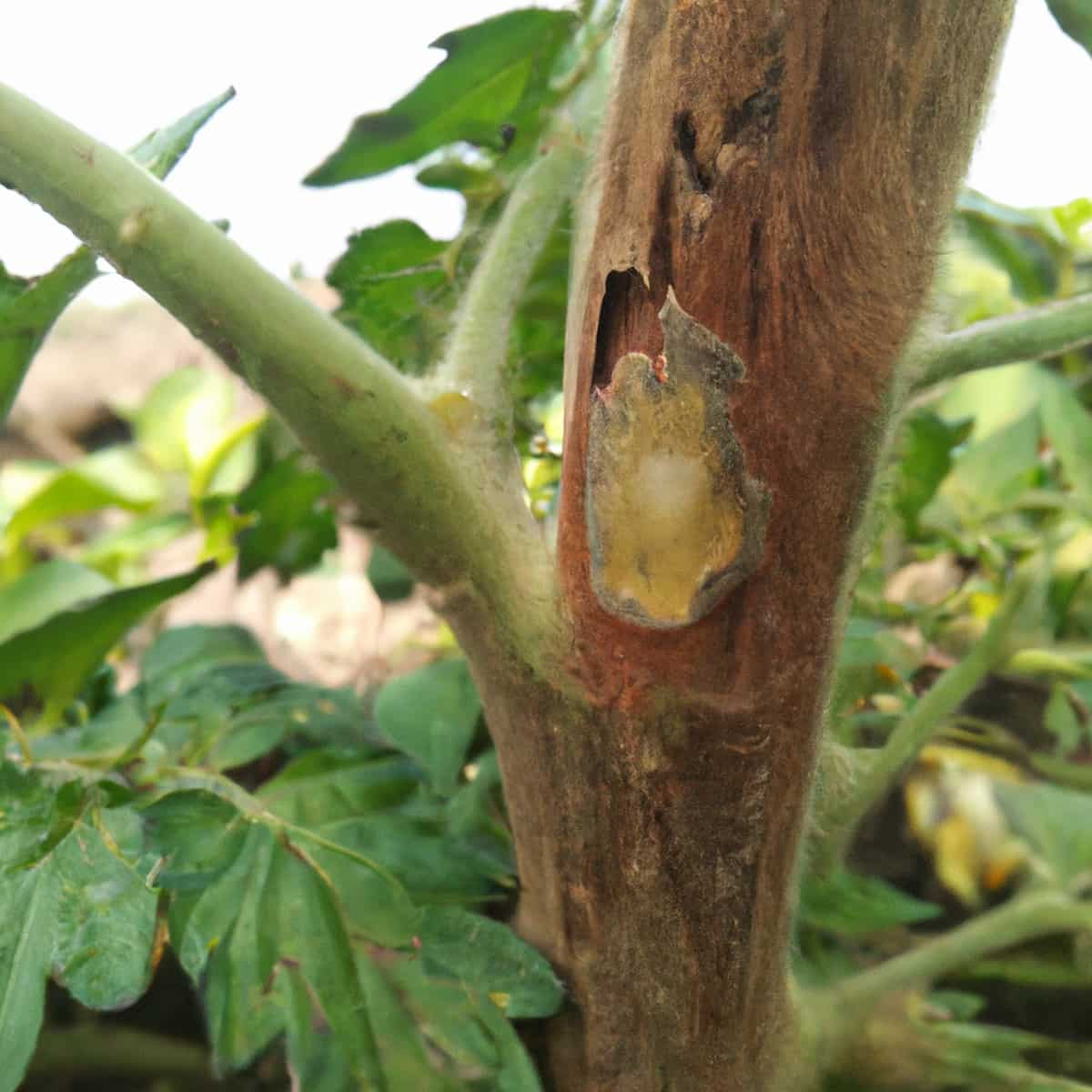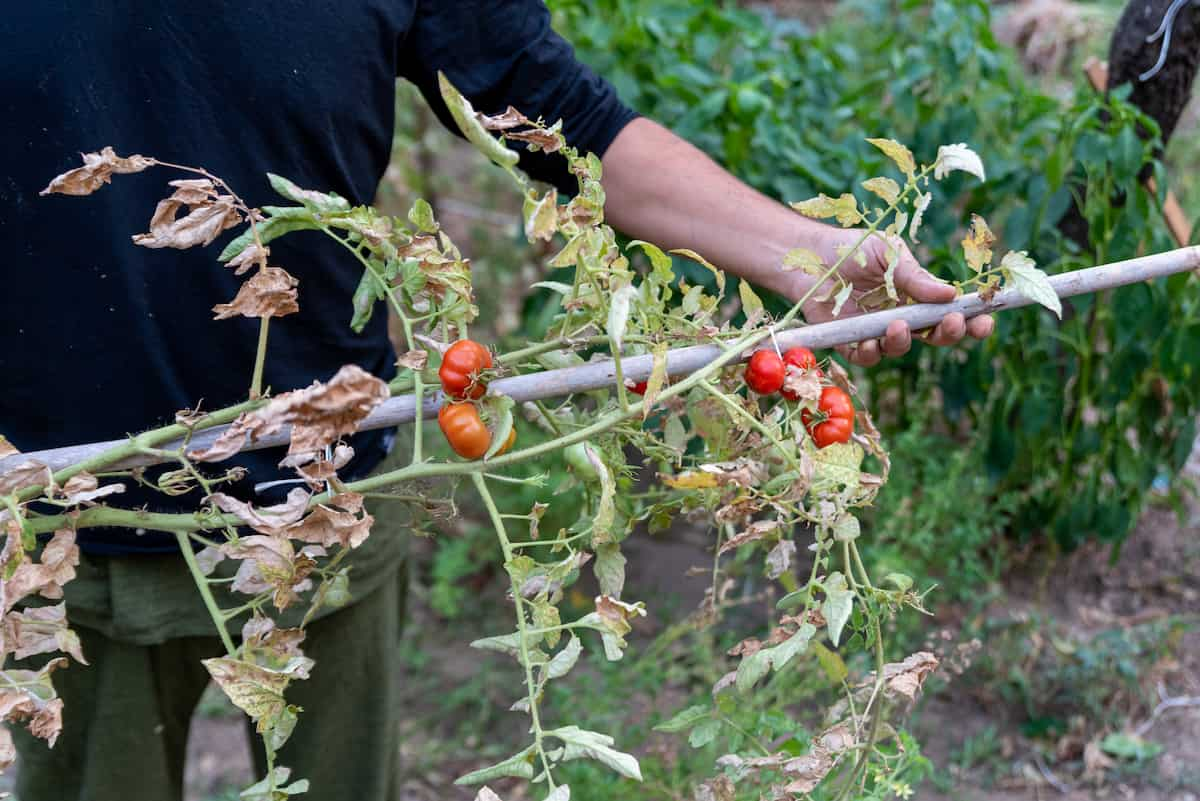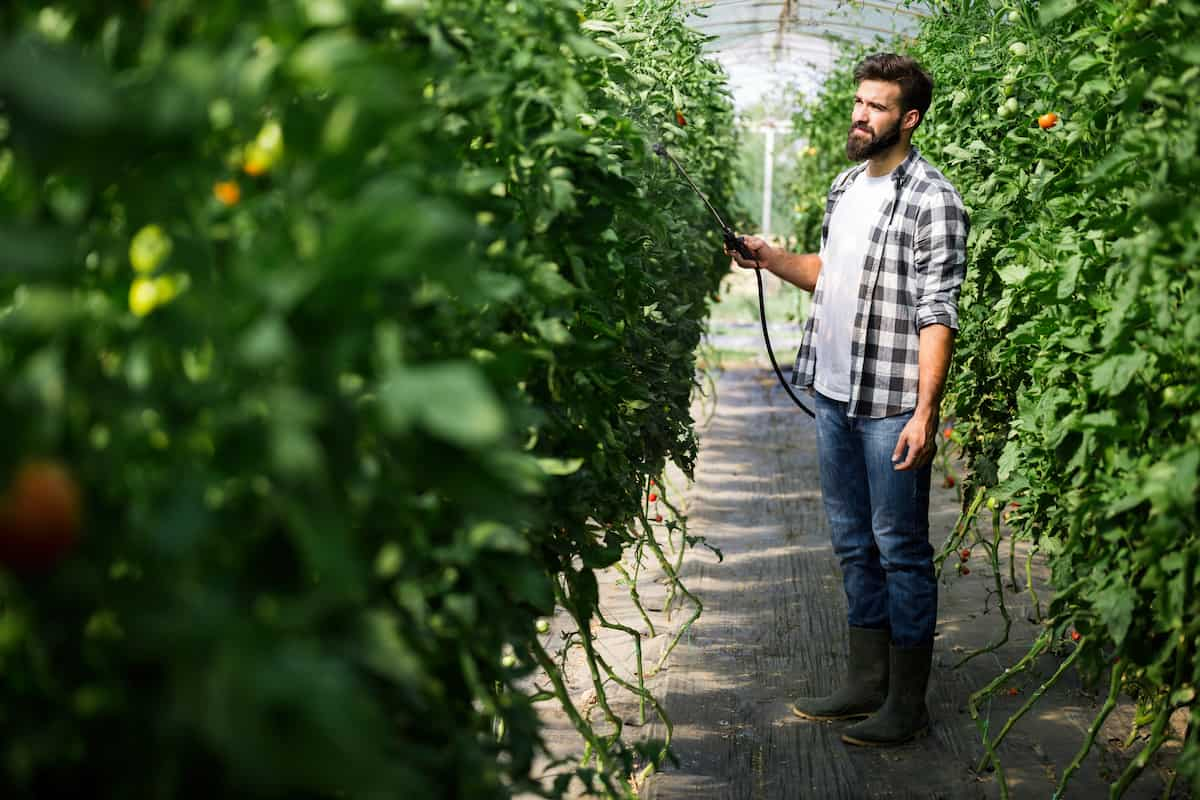Bacterial canker is a dangerous disease that affects tomato plants and can cause significant losses in commercial and home gardens. The bacterium Clavibacter michiganensis subsp causes the disease. michiganensis and spreads rapidly, making it difficult to manage. The disease has no cure, and the pathogen can be challenging to eliminate once it has been introduced into an environment.

Bacterial Canker Management in Tomato
The Causal Organism of Bacterial Canker
The bacterium Clavibacter michiganensis subsp causes bacterial canker. michiganensis (Cmm). This pathogen primarily enters tomato plantings through infected seeds or transplants. (Cmm) can be present on symptomless plants and multiply rapidly in favorable weather conditions.
The bacterium infects the plant through leaf stomata and wounds, leading to systemic infection. The disease spreads through splashing rain and human activity. It is favored by warm temperatures and high moisture or relative humidity. Once established, the bacterium can survive on plant residues for up to 3 years and on stakes and equipment for up to 7 months.
The Disease Cycle of Bacterial Canker
- The cycle of bacterial canker in plants begins with the survival of the pathogen, Clavibacter michiganensis, on buds and bark.
- The bacteria enter the plant through wounds created by frost or pruning, primarily targeting 1-year-old stems.
- The disease can spread through various means, including wind, rain, insects, contaminated propagation wood, and pruning tools.
- The ideal conditions for the bacteria to thrive and cause infections are cold weather and high moisture levels. These conditions increase the chances of the disease spreading and infecting other parts of the plant.
Causes/conditions Favorable for Bacterial Canker Disease Spread in the Field
- Humid or wet weather conditions favor the spread of bacterial canker in the field. During these conditions, slimy masses of bacteria ooze through cracks in the stem, leading to secondary infections on leaves and fruits.
- As a result, the fruits develop small, shallow, water-soaked white spots, which become slightly raised, tan, and rough. These conditions create a favorable environment for the spread of the disease, making it important for growers to be vigilant and take preventative measures to reduce the risk of infection.
In case you missed it: Tobacco Caterpillar Management in Tomato: Symptoms, Treatment, Chemical, Biological, Natural, and Organic Control

Symptoms of Bacterial Canker Disease
- Seedlings: Small white raised spots may form on leaves, with leaf edge discoloration and wilting. In severe cases, the seedling can wilt and die completely.
- Leaves: Yellow to tan patches can form between the veins of the leaves, with the edges turning brown and having a yellow border. The veins on the leaves and petioles may become dark and sunken. Lower leaves may wilt, often only on one side, and the entire plant may collapse and die.
- Stem: The stem may show brown streaks in the vascular system when cut open and split, forming long brown cankers. Yellow sticky fluid may emerge from the cut stem when squeezed.
- Fruit: The fruit may have small creamy white spots with tan or brown centers (called bird’s eye spots). The fruit surface may appear netted or marbled.
Bacterial Canker Disease Management in Tomato by Cultural Method
- Planting stock: Use certified pathogen-free seeds and transplants, and avoid using seeds from previous crops unless necessary. Consider hot-water treating or soaking the seed in a bleach solution to eliminate pathogens.
- Crop rotation: Rotate away from tomatoes and other solanaceous crops for at least three years.
- Sanitation: Remove and destroy symptomatic plants, clean up plant and soil debris, and sanitize benches, tools, and equipment. Wooden stakes should be destroyed, while metal trellis materials can be sanitized.
- Irrigation: Irrigate early in the morning to minimize the time that foliage remains wet. Use drip irrigation or a soaker hose rather than overhead irrigation once plants are transplanted.
- Avoid working with wet plants: Avoid handling the plants when the foliage is wet to prevent the spread of bacteria.
- Incorporating crop residues: Incorporate crop residues into the soil as quickly as possible at the end of the growing season to promote the thorough breakdown of potentially contaminated plant material.
Bacterial Canker Disease Management in Tomato by Chemical Method
Regarding chemical methods for managing bacterial canker in tomatoes, two main chemicals are commonly used: fixed copper plus mancozeb and Actigard.
- Using fixed copper plus mancozeb has been shown to reduce the secondary spread of bacterial canker. This is typically applied as a foliar spray.
- Actigard is another chemical that may help reduce the disease’s severity. This is typically used as a systemic treatment, which means that it is taken up by the plant and moves throughout its tissues rather than just staying on the surface.
In case you missed it: Spider Mite Management in Tomato: Symptoms, Treatment, Chemical, Biological, Natural, and Organic Control

Preventive Measures for Control of Bacterial Canker Disease
- Implement proper irrigation practices.
- Avoid overhead irrigation and use a drip or furrow system to minimize leaf wetness Water early in the morning to minimize the length of time that foliage remains wet. Reduce high relative humidity levels through proper ventilation. Implement cultural practices to reduce stress on plants
- Avoid pruning, stringing, or harvesting tomatoes when the foliage is wet. Space plants appropriately to ensure adequate air movement and light penetration. Provide adequate nutrient and water management
- Implement sanitation practices
- Remove and destroy all symptomatic plants and their immediate neighbors. Disinfect all equipment and tools used in the garden or field
- Practice deep-plowing to incorporate crop residues into the soil and reduce the buildup of pathogens
- Utilize crop rotation and alternate with non-host crops.
- Avoid saving seeds from infected crops and use only certified pathogen-free seeds.
Conclusion
The bacterial canker of tomatoes is a serious threat to crops. Effective management of this disease requires a combination of cultural, chemical, biological, natural, and organic control methods. Cultural methods such as using clean propagation material, hygiene measures in greenhouse crops, crop rotation, and optimizing plant health are crucial for preventing the introduction and spread of the pathogen. Chemical methods such as fixing copper plus mancozeb and Actigard may reduce disease severity, but prevention is the most effective strategy.
- Types of Fungicides Used in Agriculture
- Common Issues in the Fruit Development Stage of Pomegranate Farming
- Fruit Development Issues in Papaya: Easy Solutions and Treatment
- Soil-Borne Diseases and How to Protect Your Plants
- Practices to Prevent Disease Spread in the Garden
- From Wilted to Thriving: How to Treat Root Rot Naturally in Houseplants
- Natural Remedies to Cure Brown Spots on Fig Tree Leaves
- Natural Solutions for Poinsettia Problems: 100% Effective Remedies
- How to Control Calla Lily Problems: Natural Remedies for Leaf and Flower Problems